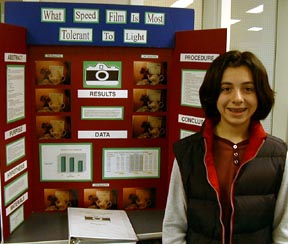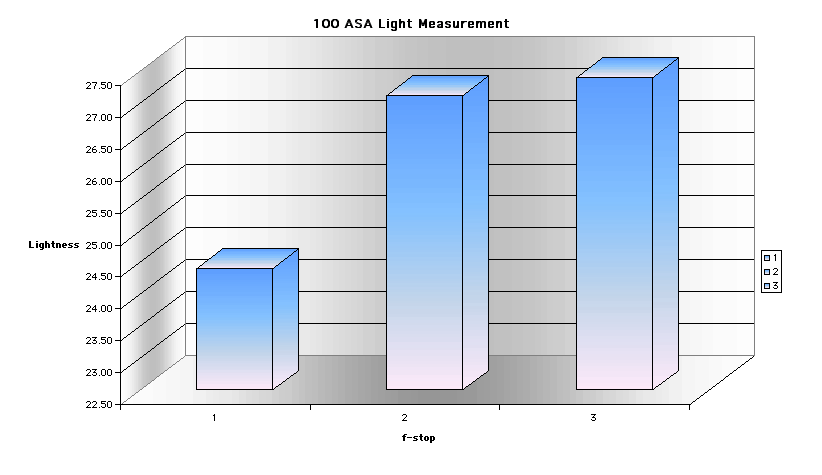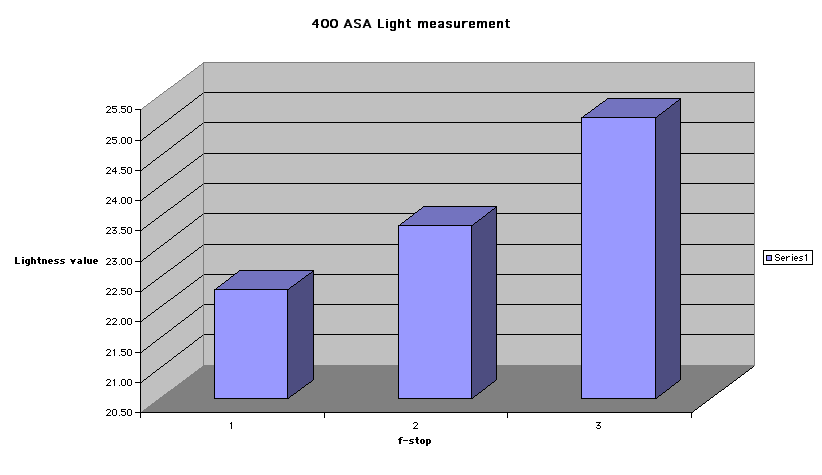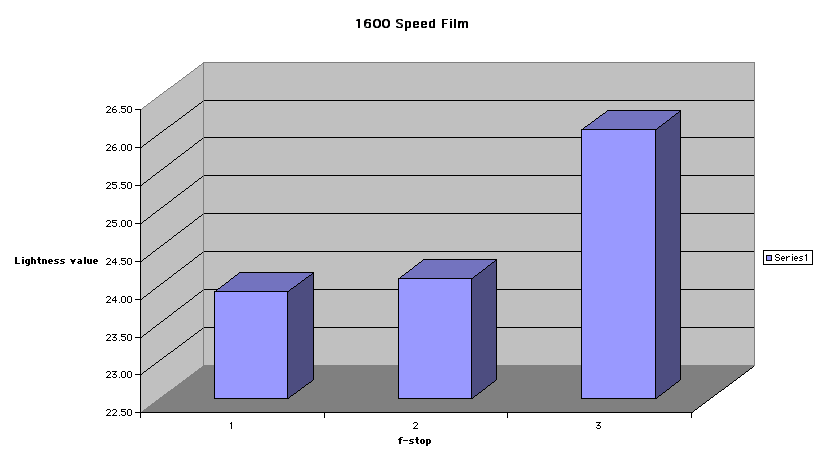|
What Speed of Film Is Most
Tolerant to Light?
|

Researched by Bethany
G.
1999-2000 |
|
PURPOSE
The purpose of this experiment is to determine
what film speed is most tolerant to light out of three speeds of film.
(100, 400, 1600 speed film)
I became interested in this idea because I have
wanted to be a photographer for awhile and have been interested in how
the film exposure process works. I have wondered how light hits the
film and how it is effected.
Photographers can use the information gained from
this experiment to see what speed of film will not be ruined or is most
tolerant, when using the wrong aperture two settings above and below the
right aperture.
HYPOTHESIS
My hypothesis is that 100-speed film is most tolerant,
going two aperture settings above and below the right aperture for that
speed of film. I think 400 speed film is second most tolerant, and 1600
speed film third most tolerant.
I base my hypothesis on data collected by photographers
saying that greater aperture with slower film does not over expose film.
They also say a greater aperture setting is best used with slower film.
Slower film is less sensitive t light. Faster film is more sensitive to
light.
To Top of Page
EXPERIMENT
DESIGN
The constants in this study were:
1 Brand of film
2 Camera
3 Room
The manipulated variable was
Film speed
The responding variable was the light hitting
the films.
To measure the responding variable I am going
to use a colorimeter to measure how much light is in the picture.
MATERIALS
| QUANTITY |
ITEM DESCRIPTIONS |
1 |
Camera |
1 |
Colorimeter |
3 |
Rolls of film ASA 100,400,1600 |
1 |
Tripod |
3 |
Lights |
|
|
To Top of Page
PROCEDURES
1. Gather materials
2. Set the camera on the tripod
3. Put 25 speed film in camera
4. Using a light meter, determine the aperture
setting for 1/60 shutter speed, and then go 2 apertures up and 2 apertures
down.
5. Take 8 pictures on aperture setting 5.3 on
400-speed film (Two apertures below )
6. Take 8 pictures on aperture setting 6.7on
400-speed film (Zero)
7. Take 8 pictures on aperture setting 9.5 on
400-speed film (Two apertures above)
8. Put 100 speed film in camera
9. Take 8 pictures on aperture setting 2 on100-speed
film (Two apertures below )
10. Take 8 pictures on aperture setting 3.5 on
100-speed film (Zero)
11. Take 8 pictures on aperture setting 5.3 on
100-speed film (Two apertures above)
12. Put 400 speed film in the camera
13. Take 8 pictures on aperture setting 6.7 on
1600-speed film (Two apertures below )
14. Take 8 pictures on aperture setting 9.5 on
1600-speed film (Zero)
15. Take 8 pictures on aperture setting 16 on
1600-speed film (Two apertures above)
16. Develop the film
17. Use colorimeter to measure how much light
is in each picture
18. Average the results of each film
and aperture setting ,then find the difference of each three averages
the different film speed and the one with the largest number is the
least tolerant etc.
To Top of Page
 |
 |
 |
RESULTS
The original purpose of this experiment was to
determine what film speed is most tolerant to light of the three speeds
of film (100,400,1600 ASA).
The results of the experiment were 100 ASA resulted
in a difference of 3.05 between the +2 f-stops and -2 f-stops demonstrating
the least tolerant film. 400 ASA resulted in a difference of 2.84, second
most tolerant. 1600 ASA resulted in a difference of 2.15 most tolerant
of the three speeds tested.
To Top of Page
CONCLUSION
My hypothesis was is that 100 speed of film is
most tolerant, going two aperture settings above and below the right aperture
for that speed of film. I think 400 speed film is second most tolerant,
and 1600 speed film third most tolerant.
The results indicate that this hypothesis should
be rejected because1600 -speed of film is most tolerant, 400 speed film
is second most tolerant, and 100 speed of film is third most tolerant.
Because of the results of this experiment, I wonder
if a speed of film I didn't test is more tolerant than 1600s-speed film.
If I were to conduct this project again I would
use more speeds of film to find out which speed of film is most tolerant
out of all speeds of film. I would also want to use the negatives instead
of the pictures.
RESEARCH
REPORT
INTRODUCTION
Photography has many different aspects.
It can be used for such things as taking pictures for fun, experimenting,
and professional photography. The goal of this report is to give you a
better understanding of the different aspects of photography.
History
In the early fifteen hundreds the first type of
camera was invented by Leonardo da Vinci. This camera was called camera
obscure (dark chambers.) Artists often used the camera obscure. The camera
obscure was a large camera. It was large enough for a grown man to
fit in. The artists would use the upside down image produced by the light
from a hole in the wall. They would sketch the image that was projected
on to the wall. Johnann H. Schulze is credited with discovering that silver
salts are light sensitive. Sir Humphry Davy started to experiment with
silver compounds. The earliest photographs recorded are called heliographs.
In 1831 Louis Jacques Mande Daguerre made photographs that were slowly
darkened when exposed to light. Dagrerre created permanent photos by coating
the photograph with a strong solution made of regular table salt. After
about 1840, cameras were greatly improved. In 1888, the Kodak camera was
put on the market. The Polaroid process was announced in 1947. Now
the digital camera is the new thing.
Film
The most common compound used to make film is
silver halide crystal. It is a kind of salt. The salt is made up of chemicals
called halogens. Halogens are chemicals called bromine, or iodine. These
chemicals are photosensitive. Color film has different types of dyes, couplers,
and other chemicals.
The speed of film is based on how sensitive the
film is to light. Fast film is very sensitive. Slow film is not as sensitive.
A fast film can produce a quality picture with less light than slower film
with less light.
Aperture Settings and the Shutter
The aperture setting is like the human eye. The
aperture or f-stop controls how much light the film is exposed to.
The light passes through the aperture. The aperture is measured by its
diameter of the widest ray of light that can enter the lens. The diaphragm
controls the size of aperture opening.
The shutter is used to let the light onto the film. It is lifted or opened
when the button is pushed. The speed of the shutter can be changed anywhere
from two seconds to one
One-thousandth of a second. The shutter speed
depends on the type of camera. You use the different shutter speeds to
add more or less light in a certain amount of time. A slow shutter will
allow the picture to have more light. A picture taken with a faster aperture
will not have as much light as a slower aperture.
Light and Lenses
Photography in Greek means, "drawing with light."
Too much light can ruin a picture but so can too little. It is important
to be able to measure the amount of light. Too much light can over expose
the film and too little light can underexpose the film. In a picture, flare
is unwanted light that causes weird reflections and loss of contrast on
the film. It often happens when the sun is in front or to the side of the
lens. Light is the ingredient that makes the picture.
Lenses can be plastic or glass. They do get scratched
easily. There are two kinds of lenses. Concave lenses curve inward. Convex
lenses have an outward curve. In photography there are three specific kinds
of lenses. They are normal, wide angle, and telephoto. In a normal lens,
the viewing is about 50 degrees. Everything appears normal in size and
shape according to Groliers 1997. A wide-angle lens has a larger view.
It is used to make smaller objects look larger or larger objects appear
close up. The telephoto has a long focus and has a smaller view than a
normal lens. It shows detail.
Summary
From the camera obscure to the digital camera
of today, photography has greatly changed over the years. Photosensitive
chemicals produce an image when exposed to the light. Aperture and shutter
speeds both influence the quality of the picture. The lenses determine
what the camera views, for example how close up or far away an object is.
The camera enables us to freeze the past in an unforgettable image.
To Top of Page
BIBLIOGRAPHY
Palmer Brian, Traub, Charals H., Tweety, Karen
"History of Photography" Encarta Deluxe 2000
"Exposure" Available at http://www.88.com/exposure
Grudberg Andy "Aperture "Encarta Encyclopedia
Deluxe, 2000
"Film and Filters" Comptons Interactive Encyclopedia,
1995
Young Scientists Volume 2 Chicago IL. World
Book Inc.,1997
Edom C. Clifton "Photography History" World Book
Encyclopedia, 1978
Volume 15,Pg.380j-380.m
|
Top of page
Menu of 1999-2000 Science Projects
Back to the Selah Homepage
|
